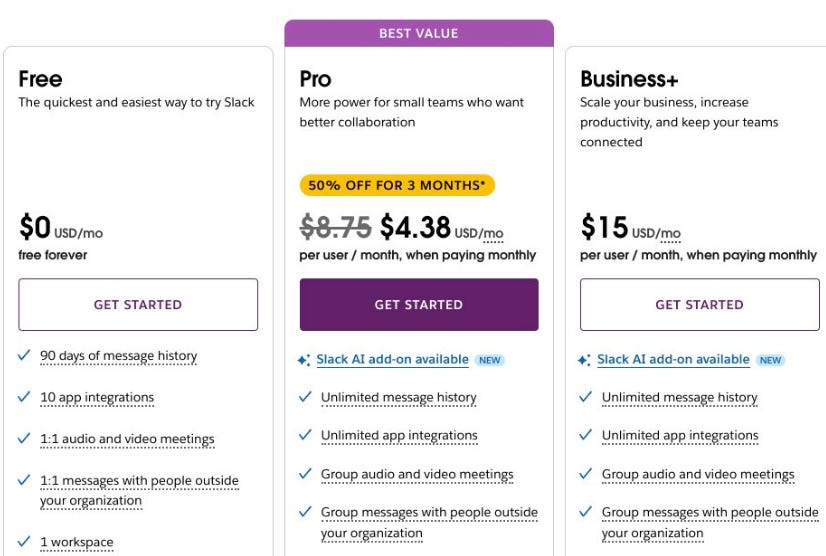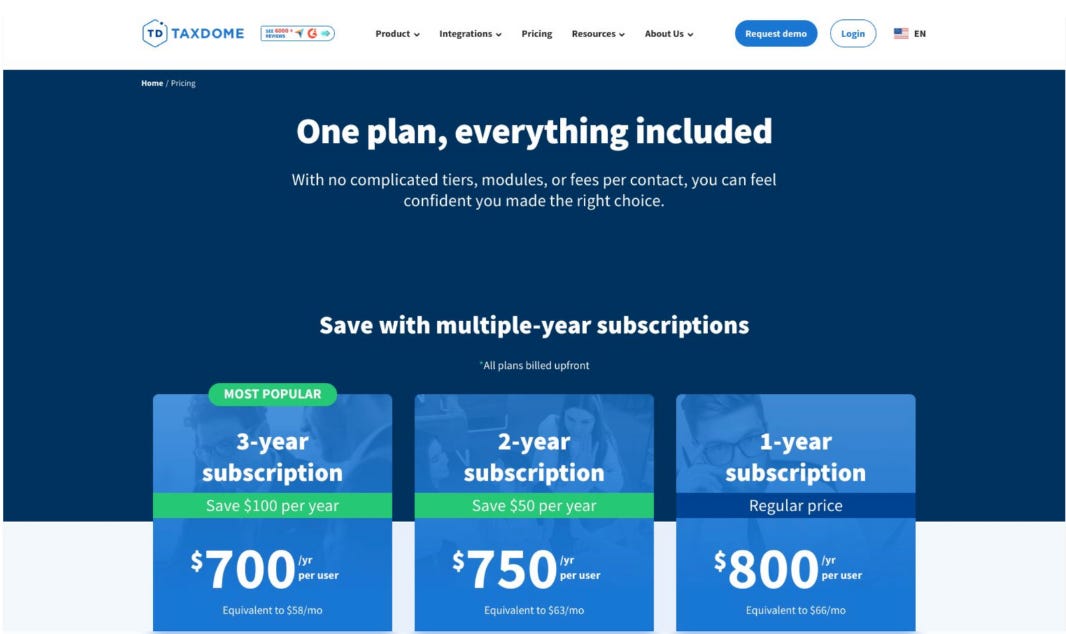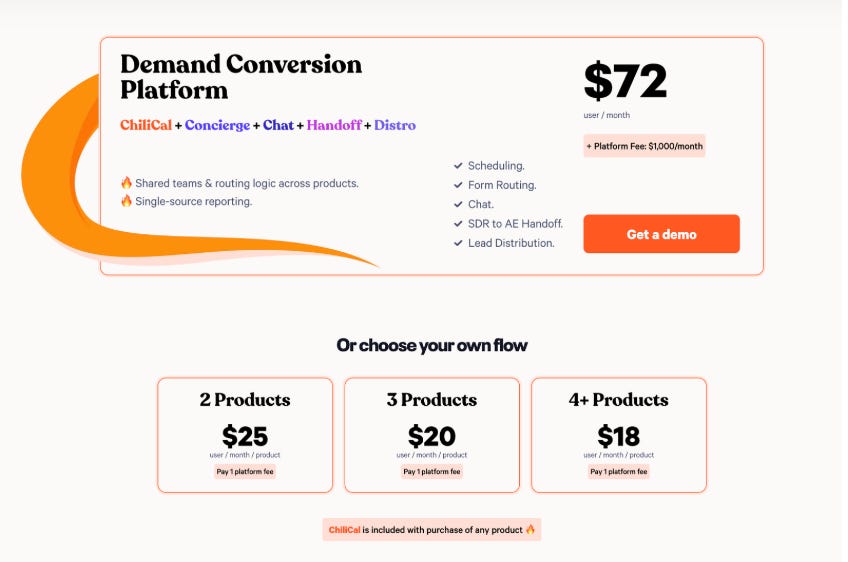The 7 Most Effective SaaS Discount Strategies (with Examples)
Plus: A free pricing engagement for one lucky SaaS company 👀
Welcome back to Good Better Best!
For readers in the US, happy 4th of July 🎆
This week we published our latest report:
👉🏼 The 2025 State of SaaS Discounting Strategy
The report highlights the 7 most popular types of SaaS Discounts, when to use them, and examples from top companies. Below, I’ve summarized our findings, but you can grab the full report here.
👀 Quick Teaser: Next week we’re launching a new service with Ulrik and the team at Willingness to Pay. As part of the launch, we’re giving away a free pricing engagement to one lucky SaaS company. Shoot me a note if you want to be added to the draw (email me at rob@pricingsaas.com).
On to today’s post.
How Zapier evolved from simple automation to AI-powered revenue growth
Zapier's Head of Business Operations, Giang Hoang, speaks with Metronome CEO Scott Woody in this podcast episode, and reveals how her team transformed pricing from a single-product model to a multi-product platform, adding pay-per-task flexibility, launching enterprise bundles, and preparing for AI-driven outcomes.
Learn the five pricing principles that guided their cross-functional approach and discover how they reduced churn while exceeding metered revenue projections.
The 7 Discount Types Every SaaS Company Should Know
While AI is transforming pricing models, one thing remains consistent: SaaS discounting.
We analyzed over 500 SaaS pricing pages and found that most companies still rely on a small set of tried-and-true discount strategies. Below, we break down the most common types, ranked by popularity, with examples from real pricing pages and guidance on when to use them.
🎯 We also trained a custom GPT on Ulrik’s best discounting resources. Just enter your pricing model, ACV, and ICP and you’ll get tailored feedback on how to approach discounting at your company. Check it out here.
1. Annual Discounts
Used by 52.7% of companies
Annual discounts are the most common SaaS incentive—and for good reason. They boost cash flow, reduce churn, and increase lifetime value (LTV). The trade-off? Lower monthly recurring revenue (MRR) on paper.
💡 Examples:
Wistia: 20%
Grammarly: 60%
NordVPN: 70%
When to use it:
If your ACV is above $5K and you operate a license-based model, annual billing should be the default. You can offer monthly plans at a premium to reduce friction in the sales process (especially for lower ACVs), but use annual as the anchor price.
🎯 Pro tip: Offer monthly-to-annual upgrades 2–3 months after signup. That’s the sweet spot where customers are engaged and open to committing for less.
2. Volume Discounts
Used by 24.8% of companies
Volume discounts reward scale. The more the customer buys, the less they pay per unit. We see this across all pricing models (license, usage, and credits).
💡 Examples:
Mailgun: Up to 44%
Jira: Up to 66%
Okta: Special pricing at 5K+ users
When to use it:
Can work across all pricing models, and is especially effective in sales-led environments. Just make sure you’re not eroding value perception or over-discounting unnecessarily.
3. Introductory Discounts
Used by 9.4% of companies
Introductory offers reduce friction at the start of the buyer journey, especially when competing with free trials. These discounts can be always-on or time-limited (e.g. seasonal promos).
💡 Examples:
Shopify: $1 for 3 months
FreshBooks: 70% off 4 months
Xero: 90% off
When to use it:
When you're trying to accelerate free-to-paid conversion. But beware: These offers often attract low-intent users, so monitor retention closely.
4. Multi-Year Discounts
Used by 6.1% of companies
These discounts offer a cash flow and retention boost on paper. But they come with baggage. If you lock customers in long-term at today’s price, you miss out on future expansion. Come renewal time, you face a steeper price jump and tougher negotiation.
💡 Examples:
Surfshark: 87% off 2-year
TaxDome: $100 off 3-year
When to use it:
Rarely. Unless:
You're defending against aggressive competition.
You’ve dramatically repriced and want to “lock in” a customer.
You offer Multi-Year 2.0: a premium-priced multi-year contract that auto-renews at then-current rates.
5. Multi-Product Discounts
Used by 5.7% of companies
Multi-product discounts encourage customers to buy more now and stay longer. This tactic increases average revenue per account (ARPA) and strengthens product lock-in.
💡 Examples:
Zoom: 35% off bundles
Lucid: 25% off
Chili Piper: 40% off
When to use it:
If you have multiple SKUs or add-ons, bundling can drive early cross-sell and shorten the path to higher-value accounts.
6. Startup Discounts
Widespread but rarely shown on pricing pages
Startup discounts are more about relationship-building than immediate revenue. You give early-stage companies favorable pricing today in exchange for future growth, referrals, and brand goodwill.
💡 Examples:
Intercom: 90% off
Amplitude: 1 year free
Mixpanel: Free Growth plan
When to use it:
If your product benefits from network effects or long sales cycles. Startup programs can help build future pipeline and reduce churn — if you stay disciplined about eligibility.
7. Migration Discounts
Rare but effective
Migration (or “switcher”) discounts aim to pry customers away from competitors. These offers usually include limited-time credits or discounts to incentivize the move.
💡 Examples:
Temporal: Offers switcher incentives
Langfuse: Migration credits
When to use it:
When you’re going head-to-head in a competitive market and need to break customer inertia. Make sure the onboarding experience matches the offer.
Closing Thoughts
Discounts are a double-edged sword. Done right, they accelerate growth and build loyalty. Done wrong, they damage long-term margins and erode brand value.
There’s also a whole world of discounts that happen behind the scenes, beyond what’s visible on the pricing page. These examples highlight low-hanging fruit for SaaS companies to experiment with.
🎯 Pro Tip: If you’re looking for discounting guidance, check out our Discount Strategist GPT. Just enter your pricing model, ACV, and ICP, and you will get customized discounting advice.
How we can help when you’re ready
PricingSaaS Community: Join the free PricingSaaS Community to get quick answers from experts, real-time pricing data, and access to exclusive events.
PricingSaaS Index: Check out the PricingSaaS Index to track competitors, scroll pricing histories, and create a swipe file of pricing pages for inspiration.
Free Advisory Session: Need a sounding board? Book a 30-minute session. No sales pitch. We’ll provide honest feedback and steer you in the right direction.










Just launched my SaaS, notestacker.cc, might have to take a look 😊